In May 2018 Ryan Lowe was installed as the permanent manager of Bury, with the North-West club having just endured relegation to League 2, the fourth tier of English football. Since then however, the club have been rejuvenated by an attacking style of play the former Liverpool youth team player has installed at Gigg Lane.
The club currently sit second in the league and are well placed to finish the season in one of the automatic promotion slots to earn a swift return to League 1. Under Lowe, the Shakers are currently the division’s highest scorers with 71 goals in 38 games. Fans of the club have been enthused by an attack-first philosophy that gained the praise of Jurgen Klopp after a pre-season friendly with Liverpool.
This tactical analysis therefore will look at how Ryan Lowe has set out to implement a style of play that is inspired by the likes of Klopp, Pep Guardiola and Brendan Rodgers.
Bury in possession
In possession Bury set out in what can be described as something resembling a 3-5-2 or 3-4-3. With a fluidity in their movement and positioning, however, their offensive shape takes many forms as they play.
The key players in this system are Danny Mayor and Jay O’Shea who act as two number 10s, and operate in inside positions close to the centre forward. Bury’s best play usually comes through them where they are a constant threat to League 2 defences. Both wing-backs will take up aggressively high positions early in the build up to pin back opponents and create space inside for Mayor and O’Shea.
They will look to play out from the back, but they are not a team that will circulate the ball endlessly probing for gaps . The primary aim is to progress the ball into the final third of the pitch. In this they can be described as direct, but they are far from a long-ball team. They demonstrate exciting and inventive movement and combination play in the final third.
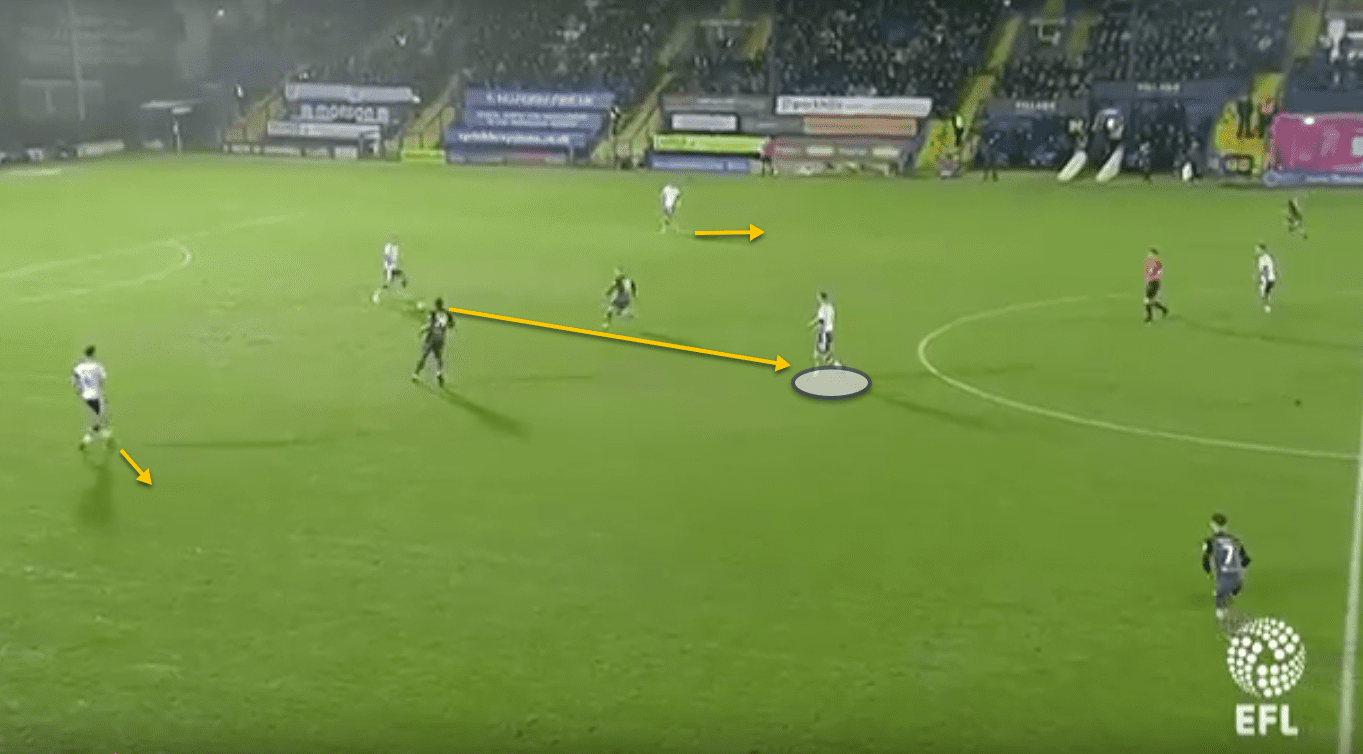
Here there is no great pressure on Bury’s back three so they will look to play out from the back through midfield. The back three split, although both outside centre backs do not display the most open of body shapes to receive the ball. Nor does Dagnall the central holding midfielder, who looks to collect the ball behind the first line of pressure.
If they are put under pressure, they will not look to manipulate the press and play through it, but will look to play longer passes into the final third. Here they know that they have their front players close together so that if they do not receive the ball themselves, they are positioned in a way that they can recover the ball through rapid counter-pressing. This is a tactic that may be inspired by Jurgen Klopp’s Borussia Dortmund side, who would intentionally create turnovers high up the pitch to create counter-pressing situations.
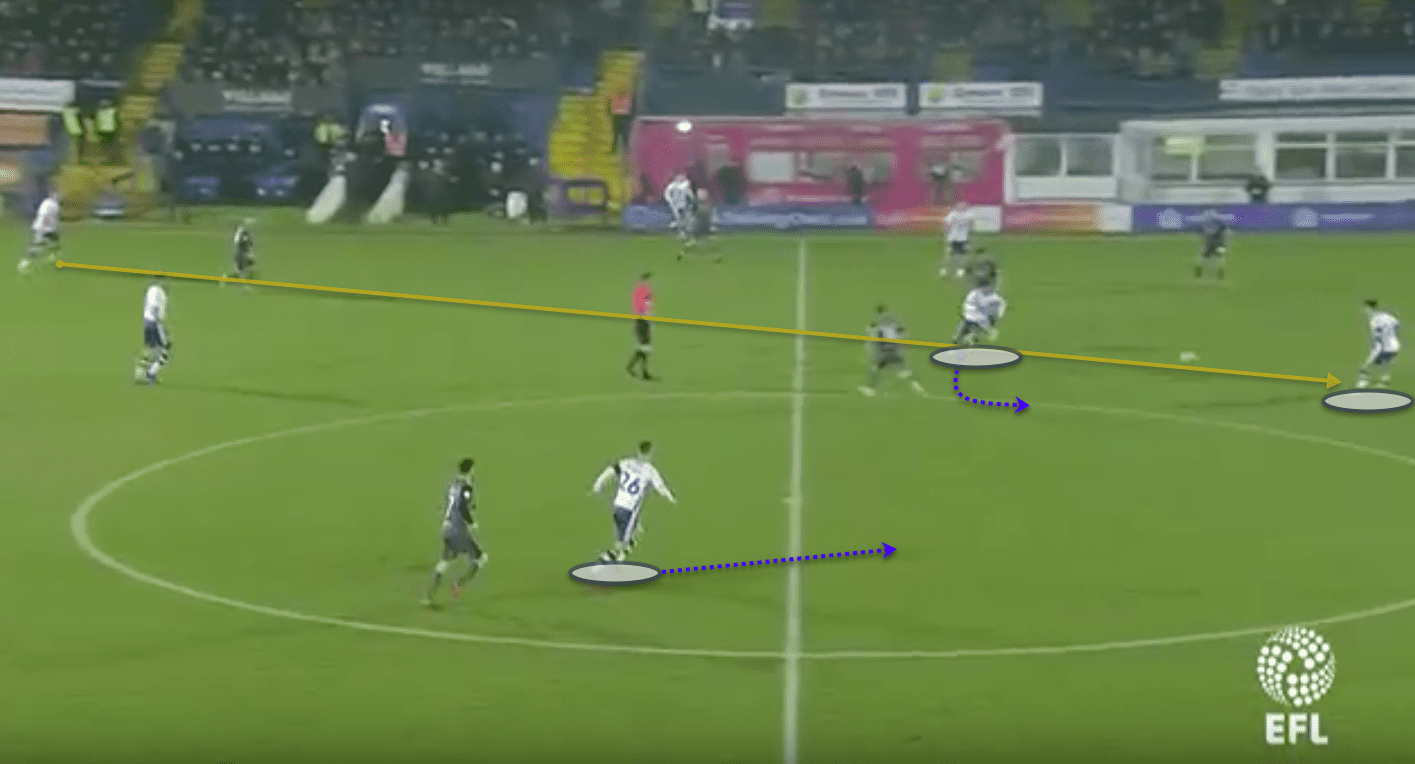
In this situation the left sided centre-back plays a flat, diagonal pass into the furthest player forward which triggers movement from both players in support. This is a clearly trained element of their game, as both Maynard and O’Shea quickly recognise the trigger to make supporting movements as the ball is moving.
Maynard spins in behind his marker and O’Shea runs off the back of his marker to receive a first time lay-off, and Bury now have freed a player in between the lines to attack the last line of defence.
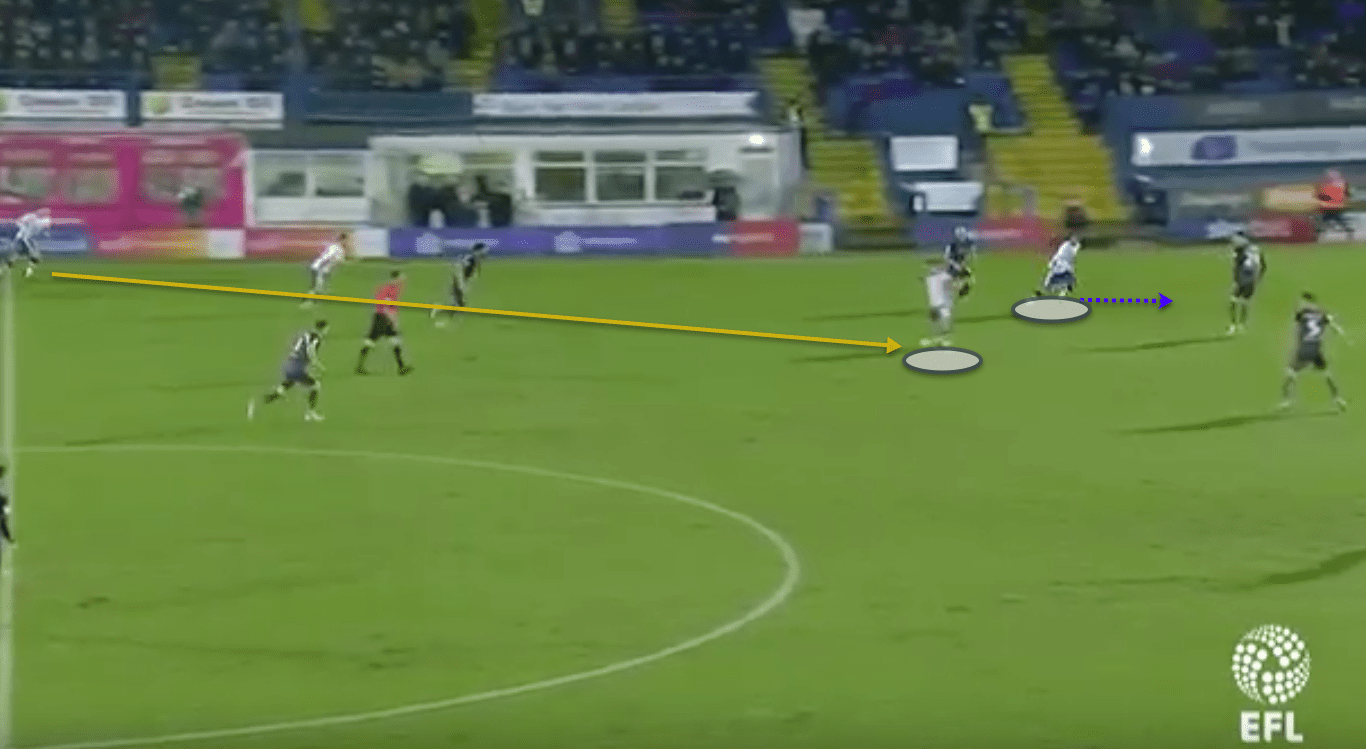
This time O’Shea has dropped into a pocket of space between the lines to receive a diagonal pass inside. Notice how each Bury player in this clip is now making a forward run in support, and Maynard as the centre forward immediately threatens the last line of defence with a run in behind.
O’Shea perhaps could receive the ball with a more open body shape to play forward more quickly, as he does not this on this occasion have a supporting player to set the ball back to first time.
Why does this narrow forward three cause so many problems for opponents? For a start, this is not a traditional shape that defences will be accustomed to playing against. Bury will have profited from an element of surprise during the season as defences simply do not have the same experience as they would against more traditional attacking shapes.
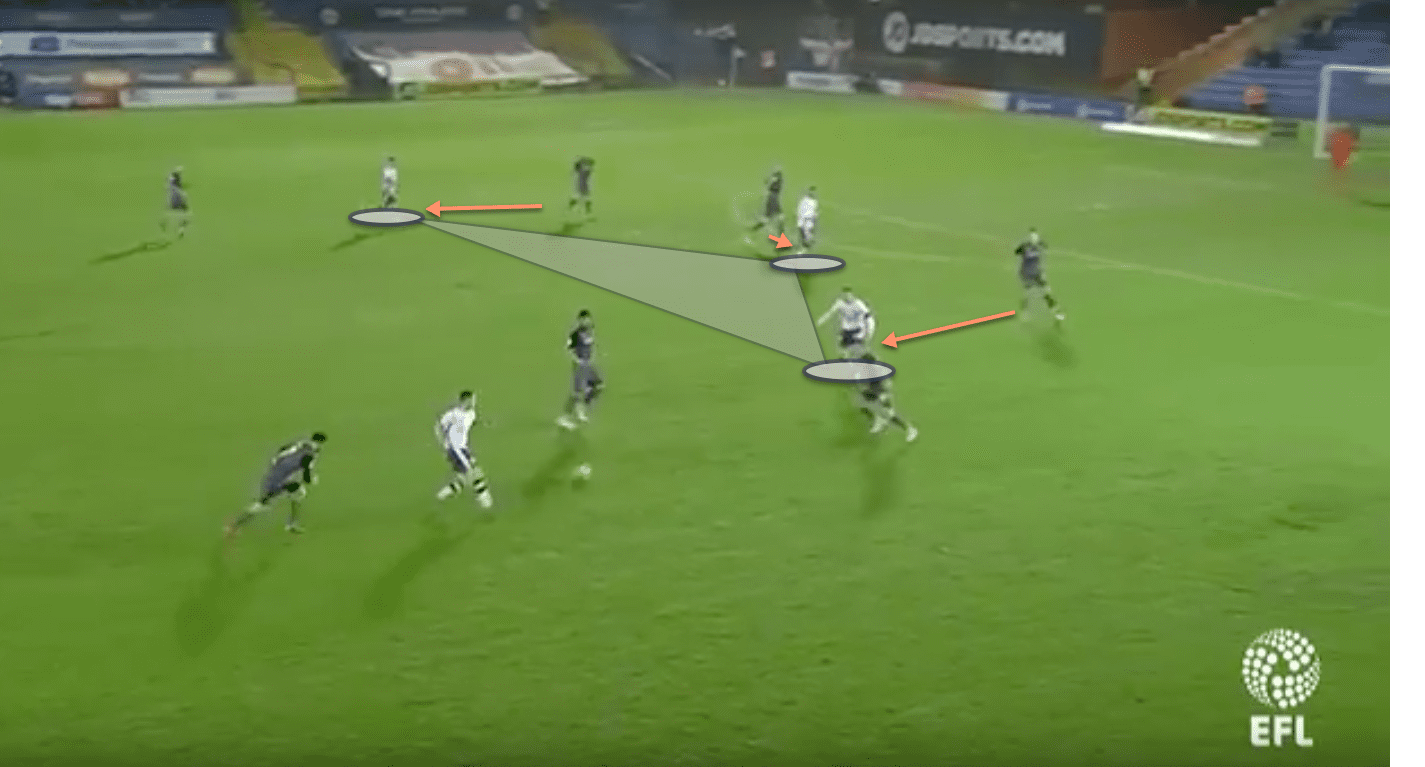
Here you can see how the narrow positioning of the front three is causing problems for the opponent. They will often position themselves with the centre forward playing on the last line of defence, and the two number 10s just off the defensive line, using clever high-to-low movements to free themselves.
This positioning naturally draws the opposition back four narrow, with the full-backs unsure whether to follow Mayor and O’Shea inside to mark them, or allow them to receive and turn. In this example the opposition left-back is drawn infield, as well as the left sided centre-back who steps out to engage O’Shea receiving the ball. This leaves both Maynard and Mayor one-on-one against their markers, ready to take advantage of a completely disorganised defence.
The positioning of the forward players dragging the opponent defensive line into a narrow shape creates lots of space down both flanks, which brings both of Bury’s wing-backs, McFadzean and Adams, into play. Both players will position themselves high up the pitch early in the build-up which creates a dilemma for opponent full-backs about whom they should mark.

In this situation O’Shea has received the ball inside, and has attracted the attention of the opposing left-back. Again, showing clear coordinated movement, as soon as the ball is travelling forward movements from both wing backs are triggered as they look to exploit the space left in behind the full-backs.
Attacking with numbers
Once the ball is secured in the final third, Bury will then flood the forward areas with runners attacking the penalty area, overwhelming their opponents. The wing-backs will regularly get into crossing positions, as Bury flood the box with runners to finish or pick up second balls. It is not uncommon to see Bury attacking with six players at a time, with four players left back to provide security (usually the back three and a screening midfielder).
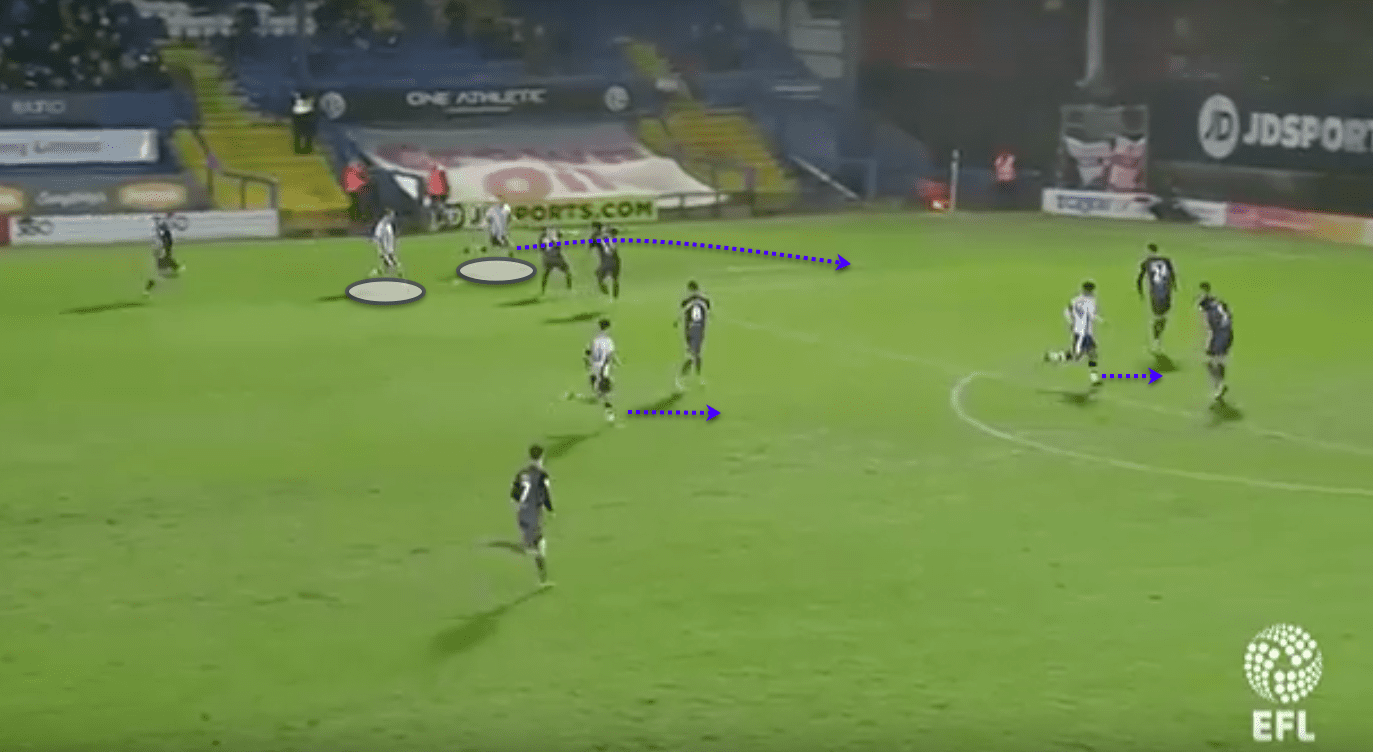
Here Mayor has released the wing-back McFadzean down the left flank, as runners attack the box in a typical Bury attacking move.

Notice here how the right wing-back Adams is actively attacking the back post, where he picks up a second ball to get on the scoresheet.
Counter-pressing
This relentless attacking from Bury committing many players forward means they require a very aggressive counter-press in order to not get caught once they turn the ball over. In this aspect of play, the narrow positioning of the forward players and both number 10s means they have a high concentration of players close to the ball when they lose it. As a result, they can instantly protect their goal once the ball is lost.
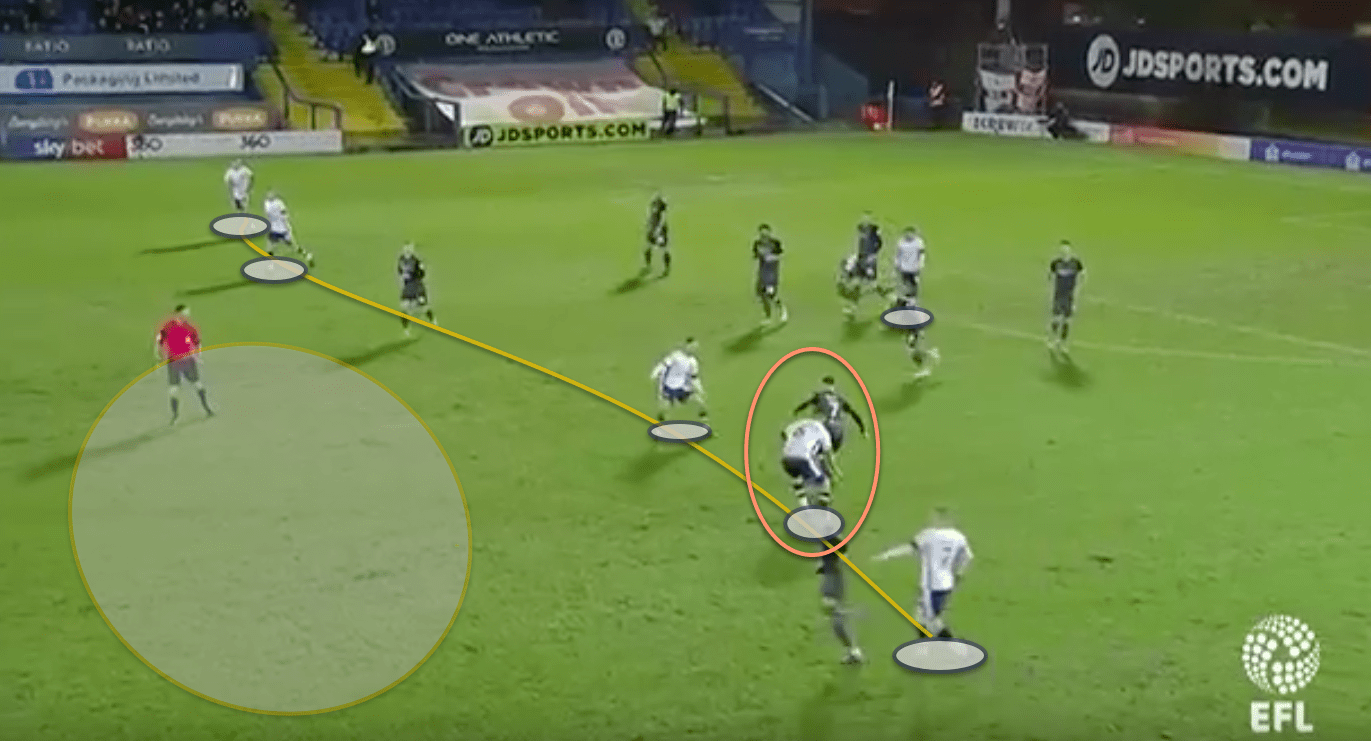
This example shows a counter-pressing moment where centre-back O’Connell (#6) steps forward to press immediately on the defensive transition. Whilst successful on this occasion, notice the flat line of five Bury players and the large gap in behind this line of pressure. If this wave of pressure was broken this would have resulted in the defensive line being exposed with six Bury players the wrong side of the ball.
It is difficult for coaches to coordinate an effective counter-press which requires plenty of time on the training ground. However, there appears to be no problem in the defensive reactions they show once the ball is lost. If Bury are promoted, Lowe will need to mold these positive reactions into a well coordinated counter-press as better players will expose weaknesses in this approach.
Out of possession
Bury are very rarely pushed back into their defensive block, but when they are they assume a 5-3-2 shape.
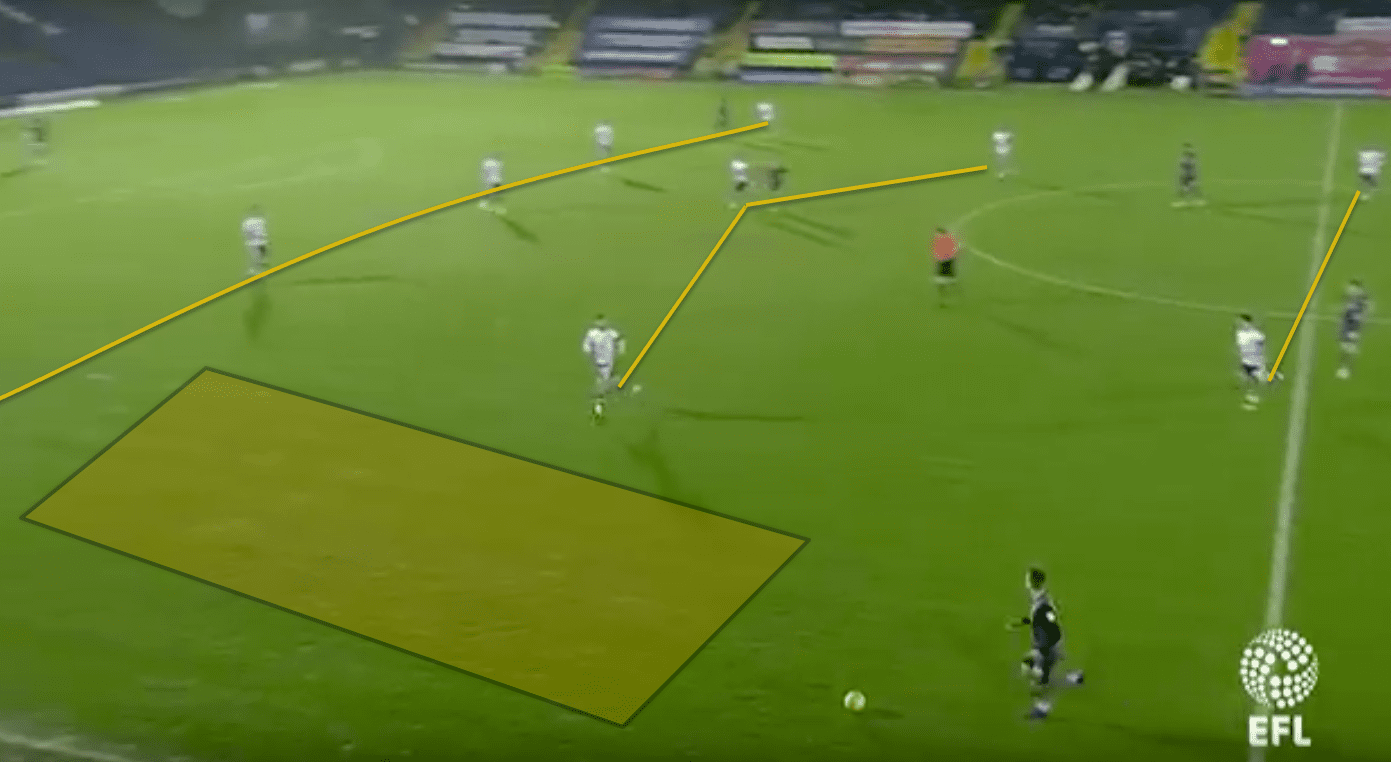
In their defensive organisation they are not particularly horizontally compact, and do not shift as a unit quickly enough towards the near side. Here the midfield unit has not shifted quickly enough, leaving their right flank open for the opponents to advance. The spaces between the three are large as the central defensive midfielder prefers to man-mark his opponent rather than shift across to create more compactness close to the ball.
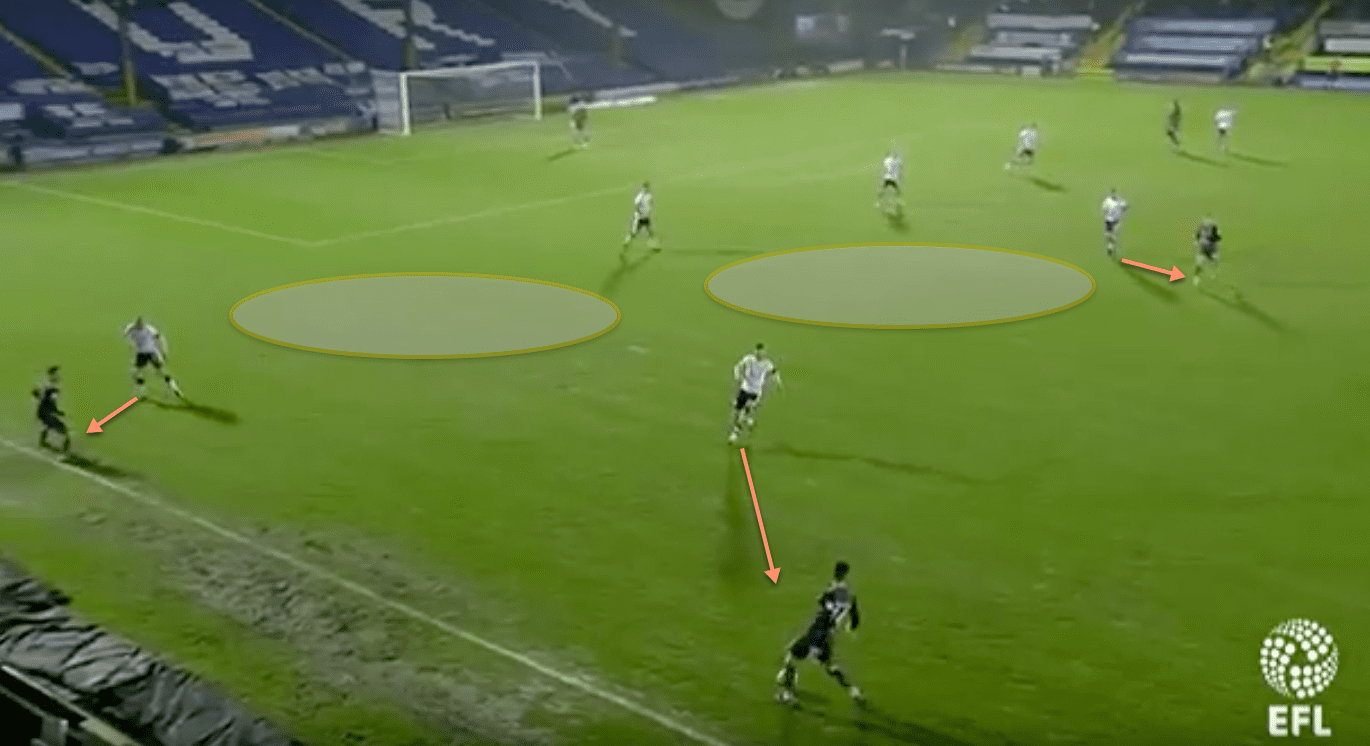
As the play develops, Bury’s man-orientation in the defensive phase becomes apparent as defenders are more focused on marking their opponents than creating a compact defensive block.
As the right wing-back Adams closes down the ball carrier this opens up a large space in the inside channel as the back three do not shift across to block the resulting gap. The midfield man-marking scheme leaves gaps to be exploited between and behind them which on this occasion is not exploited.
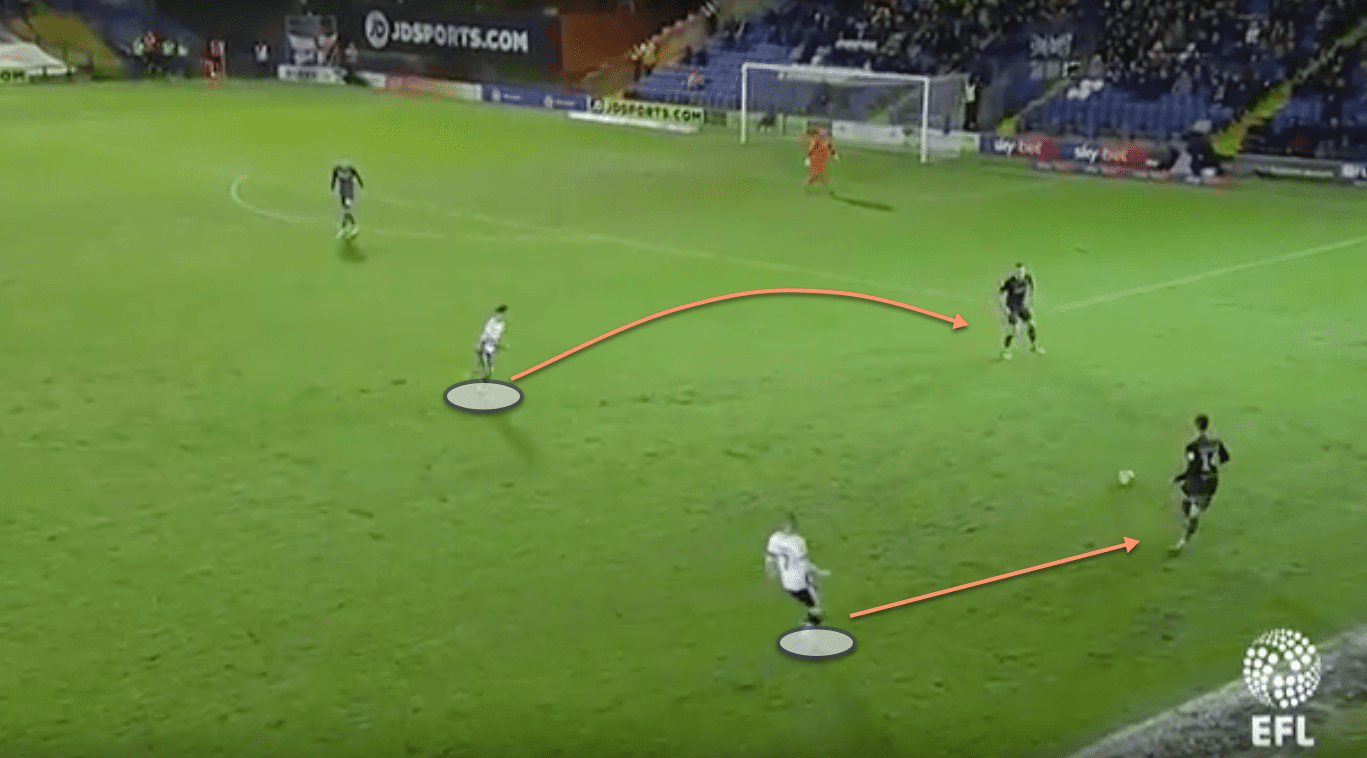
Bury are far more comfortable pressing high up the field to disrupt their opponents’ possession and looking to force turnovers. Notice how Adams is positioned high up the pitch to close down the opposing full-back as the opposition build-up. Maynard then curves his run to block the opposition centre-back from circulating the ball to his defensive partner.
This pressing scheme is designed to force the centre-back into playing a hopeful long ball down the line, where the ball can be recovered.
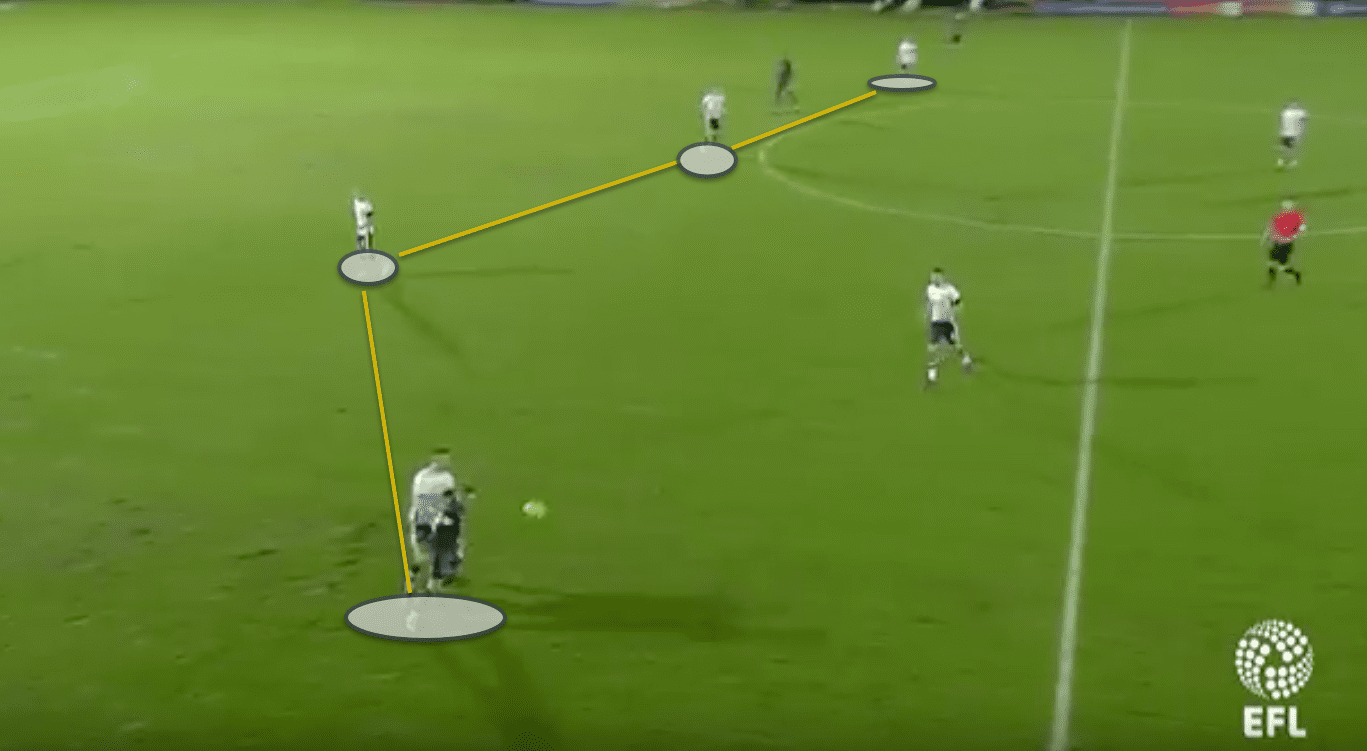
On this occasion the Bury defensive unit has shifted across adequately, as the right centre-back covers the full-back area, with the middle centre-back, Thompson, covering in behind in case the duel is lost. The left wing-back, McFadzean, has tucked in to create a situational back four.
Dealing with long goal kicks
One potential defensive weakness that Ryan Lowe’s Bury demonstrate is from long goal kicks where they do not adequately screen their back three.
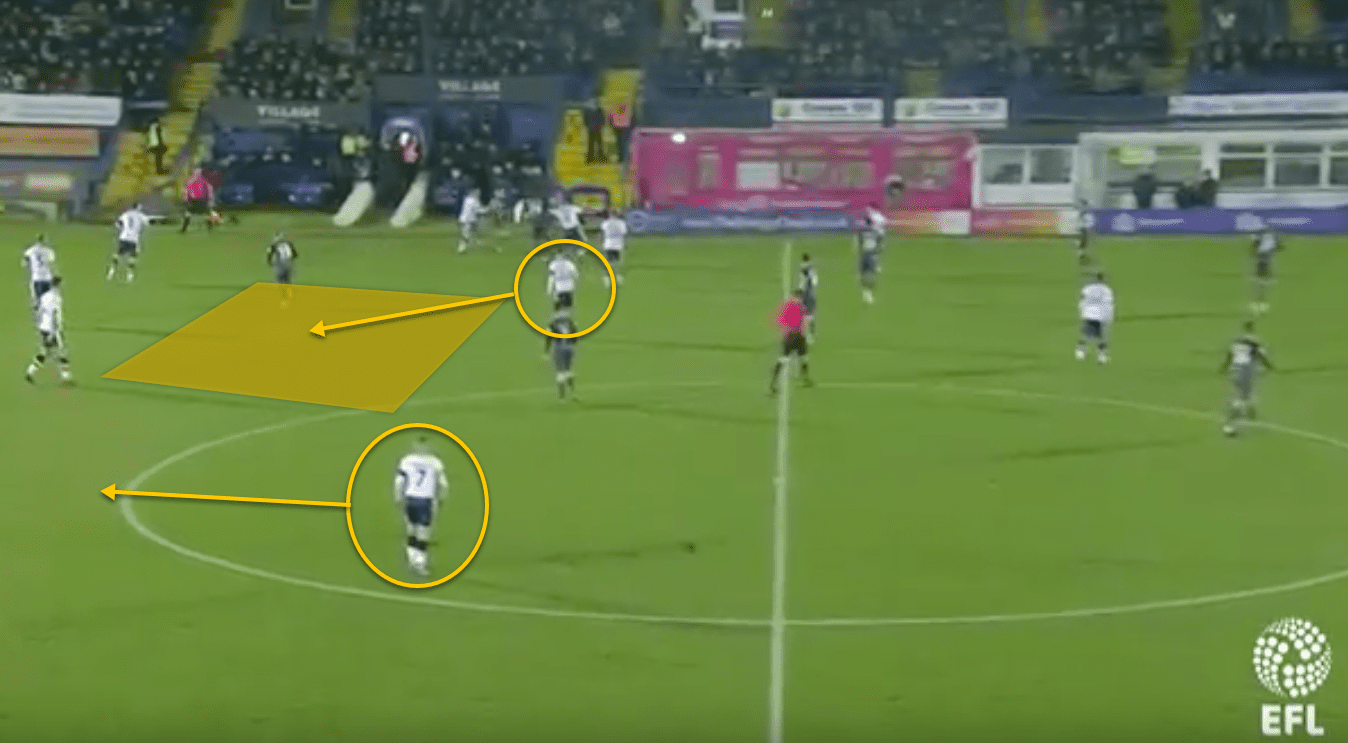
Here as the opponents play a long goal kick Bury lose the first duel, with the second ball arriving at the feet of the opposition centre forward in the highlighted space, which is left uncovered. The right wing-back could perhaps tuck in more to provide an extra covering defender.
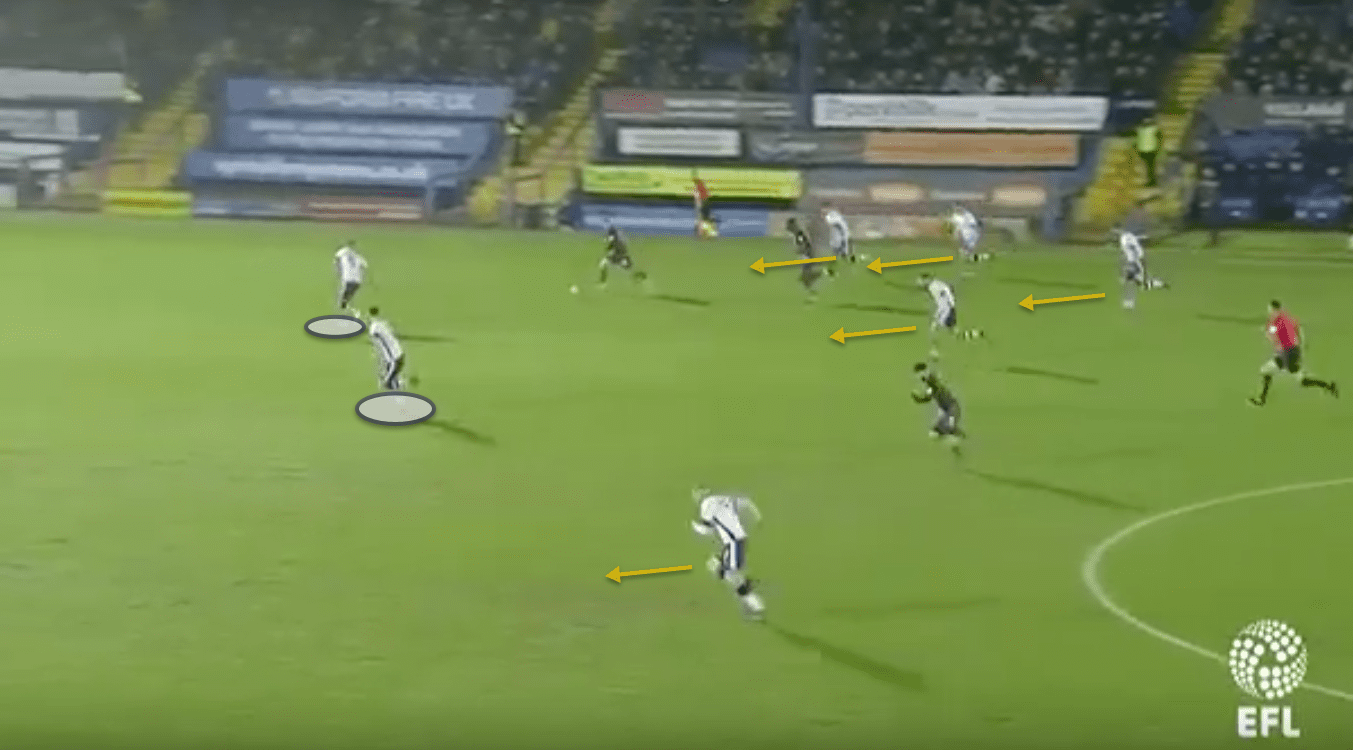
With the first contested duel lost, and the second ball dropping kindly for the opponent, suddenly the Bury defence is back-pedalling as the entire midfield line is caught the wrong side of the ball.
What next for Ryan Lowe and Bury?
As Lowe approaches the end of his first full season at Gigg Lane, there is no doubt that his attacking philosophy has captured the imagination of the Bury crowd. Five points clear of fourth place with a game in hand leaves automatic promotion a distinct possibility. It will be enormously interesting to see whether this talented young manager can adapt to the greater demands of League 1.
If he remains true to the relentless attacking that has defined his first full season in charge he will need to work on coordinating his counter-press. Better sides with better players will take more advantage of spaces left unguarded once they lose possession.
Promotion will also mean Bury will have to spend longer periods of time without the ball and in a defensive organisation that does not come naturally to them. Lowe might consider how he sets this up. They will need to be more compact out of possession if they are to make a success of League 1.
Lowe has an interesting conception of the game, and is clearly influenced by Jurgen Klopp’s dynamic style of play. It must also be remembered he is a relatively young coach in football terms who is still developing himself, and League 1 will be a proving ground for his talents. If he has enjoyed having superior player quality at his disposal in League 2, he will have no such advantage in a higher division which will test his team-building capabilities.
One thing is for certain however; it will be entertaining to watch.
If you love tactical analysis, then you’ll love the digital magazines from totalfootballanalysis.com – a guaranteed 100+ pages of pure tactical analysis covering topics from the Premier League, Serie A, La Liga, Bundesliga and many, many more. Buy your copy of the March issue for just ₤4.99 here, or even better sign up for a ₤50 annual membership (12 monthly issues plus the annual review) right here.

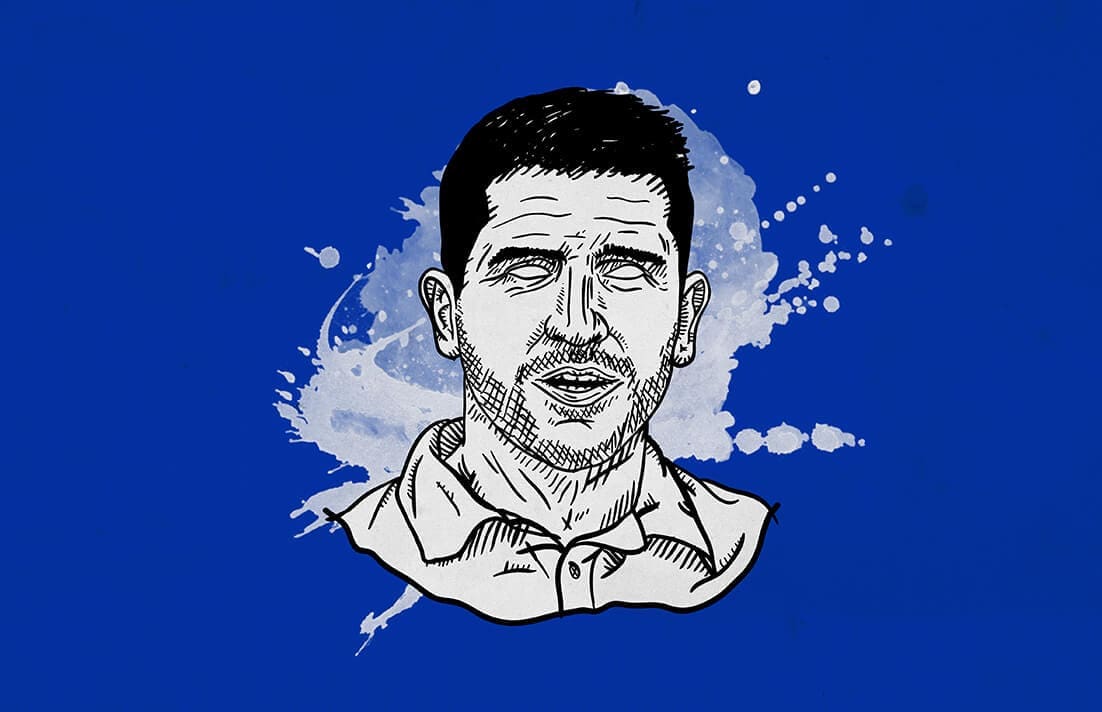



Comments